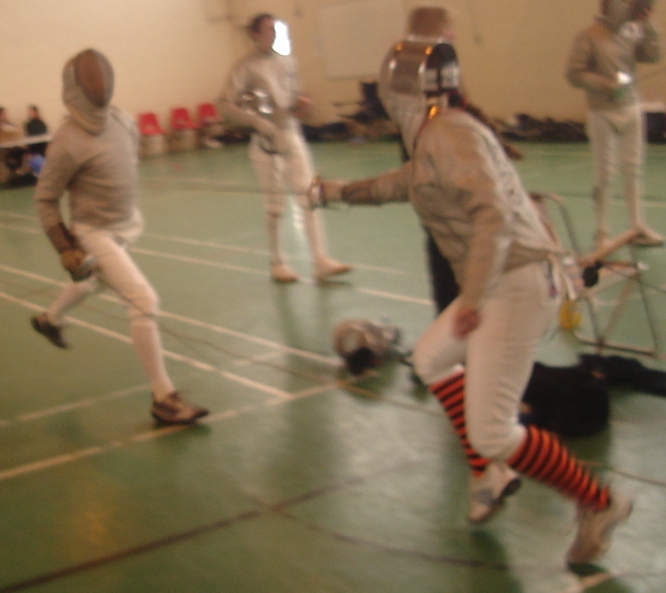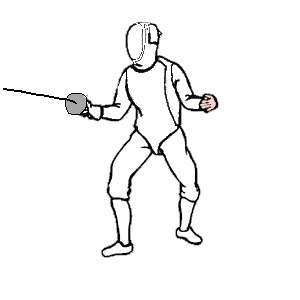Fencing is a sport with some serious history behind it - our fencing club teaches the modern style of olympic fencing that evolved during the European Renaissance.
 We use three weapons - the Foil, Epee and Sabre. We have specialized coaches in all three, and beginners can take their pick when they first start training.
We use three weapons - the Foil, Epee and Sabre. We have specialized coaches in all three, and beginners can take their pick when they first start training.
We compete in open competitions up and down the country, and have a bursary for providing transport and entry fees to any fencers who might want to compete. We also have several sets of electrical equipment so you can compete within the club. Of course, the most important thing in any sport is to enjoy yourself, so this is by no means mandatory.
We have a group on facebook, which is regularly updated with pictures and event information.
The sword is one of the oldest weapons and many different types have been used throughout history. Today fencing is one of the fastest and most technologically advanced sports in the world. The ancient Turks used bronze swords as far back as 3000BC, and the development of iron working and eventually steel allowed armies to produce weapons that were far larger, sharper and more deadly. On the medieval battlefield knights used enormous two-handed swords, but with the development of reliable firearms swords ceased to be primary battle weapons and became smaller and quicker and the techniques of swordsmanship changed with them. Throughout the 17th and 18th centuries the preferred weapons in a duel were rapiers, which were supplanted by the épée towards the end of the 1700s.
Modern fencing is an Olympic sport and fencers spend many hours developing the skills, speed and fitness required to succeed in national and international competition where three types of sword are used by both men and women. Fencers train at all ages and competitions range from Under 10 to Veterans events.
The Swords
There are three types used in modern fencing:

The foil - a light, flexible sword. Hits can be scored by thrusting the point at the opponent's trunk. Hits on the arms, legs and head do not count. The foil is a popular weapon, combining elements of both epee and sabre strategy.

The epee - a heavier thrusting sword. Valid hits can be scored with the point on any part of the opponent's body. Unlike the other swords, the epee has no 'priority' rules, so one hit equals one point regardless of who happens to be attacking or defending. This rule makes epee a very tactical and defensive discipline.

The sabre - valid hits can be scored with the point or with the edge on any part of the opponent's body above the waist. Sabre bouts are very quick and aggressive and combatants need excellent reflexes to succeed. The sabre is notable for being the only weapon where your goolies are not a valid target.
Other Fencing Equipment
Mask - Worn over the head to protect the face and eyes.
Jacket - made of a strong material to protect body and arms.
Breeches - Short trousers made of the same strong material as the jacket and allows ease of movement.
Shoes and socks - sport shoes and knee length socks for non-slip soles and lower leg protection.
The Language of Fencing
On Guard - The stance fencers use while fighting.
Lunge - The basic attack, stretching the arm forward to strike at the opponent.
Parry - Using your sword to block your opponent's attack.
Riposte - A counter attack after parrying.
Piste - The area used by two fencers while they are fighting each other, about 2m by 14m.
Halt - Stop fencing immediately - used either as point is scored, time for the match is exceeded or a dangerous situation has arisen.
Information for Members
Information to all members is given verbally and in written form at the Fresher's Fair. More detailed information will be given out at the first training session. Any further information will be displayed on the Fencing Club noticeboard in the sports corridor of the Students' Union building, or distributed through email. Information about instructions for new members is advertised on the club noticeboard.
Information given
Information is given about training sessions and competitions, and the arrangements that relate to these. All club members are given a copy of the code of practice and are required to sign a declaration to say they will read and abide by it.
Facilities
Training and home matches take place in the activity room at the Manor Road sports hall. Times and arrangements are displayed on the club notice board. Sports hall staff are qualified first-aiders. A first-aid kit and telephone are available in the sports hall reception. An accidents must be written in the accident book.
Equipment
Club equipment is kept in a locker at the Manor Road sports hall. Access to the equipment is restricted to those whose names have been given by the Club Captain to the Sports and Recreation Manager. The club provides basic equipment for beginners. More experienced fencers are expected to provide their own equipment. Either the Club Captain and/or an appointed Equipment Officer are responsible for the club's equipment. An up-to-date log of all club equipment must be kept by the Captain or Equipment Officer detailing quantities, type, when bought, cost and condition. Equipment must be checked on a regular basis and any which is faulty must be logged, removed from use and repaired or handed to the sports hall supervisor for safe disposal. Members must draw the attention of the Captain or a committee member to any faulty or unsafe equipment so that it can be withdrawn immediately from use. Details of new club equipment, or equipment disposed of, must be notified to the Sports Association so that the insurance schedule can be amended. Instruction on the use of fencing equipment by novices will be given by the Captain or experienced committee members. No novice fencer may use club equipment unsupervised. Standards on equipment safety will be in accordance with the guidelines given by the BUCPEA 'Safe Sport in Universities' guide. Copies are available on request from the Club Captain or from the Sports Association office.
Discipline
Any member who is deemed to be fencing in an unsafe manner, or whose behaviour brings the club into disrepute, will be made aware both verbally and in writing by the Club Captain or the Coach that such actions are unacceptable and may lead to expulsion from the club. Two such warnings within one semester will mean termination of membership without repayment of membership fees. This decision will be made by the Club Captain in consultation with at least one other member of the committee.
Affiliation
The club is affiliated with the British Fencing Association
Insurance
Every member must have a valid Sports card which includes the Sports Association's sports injury cover.
